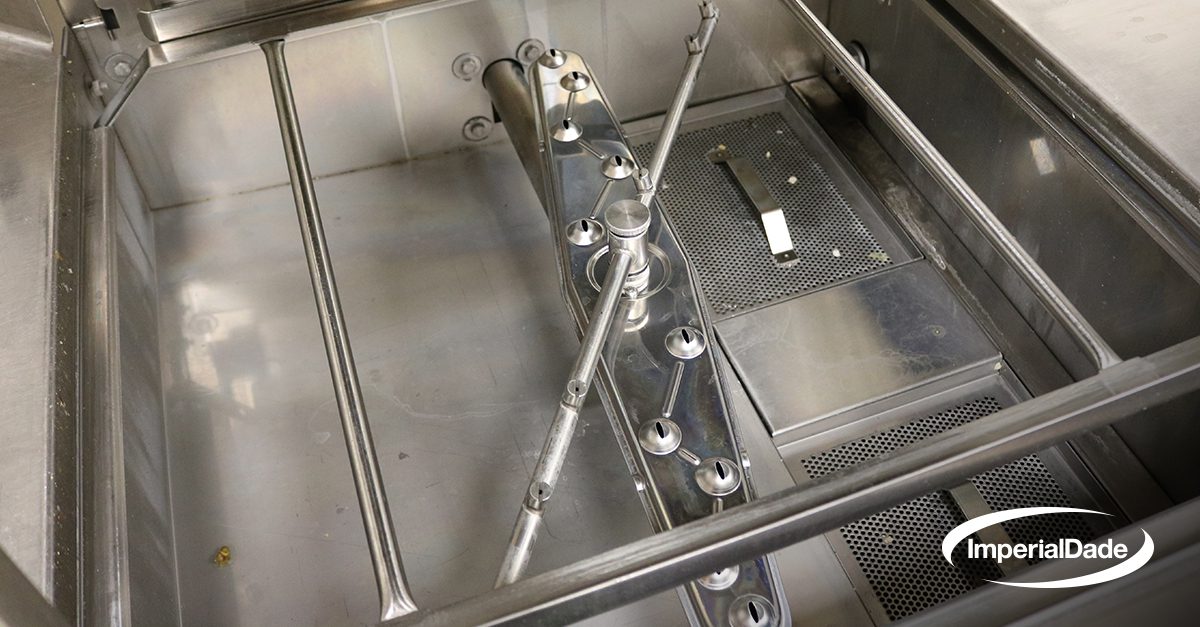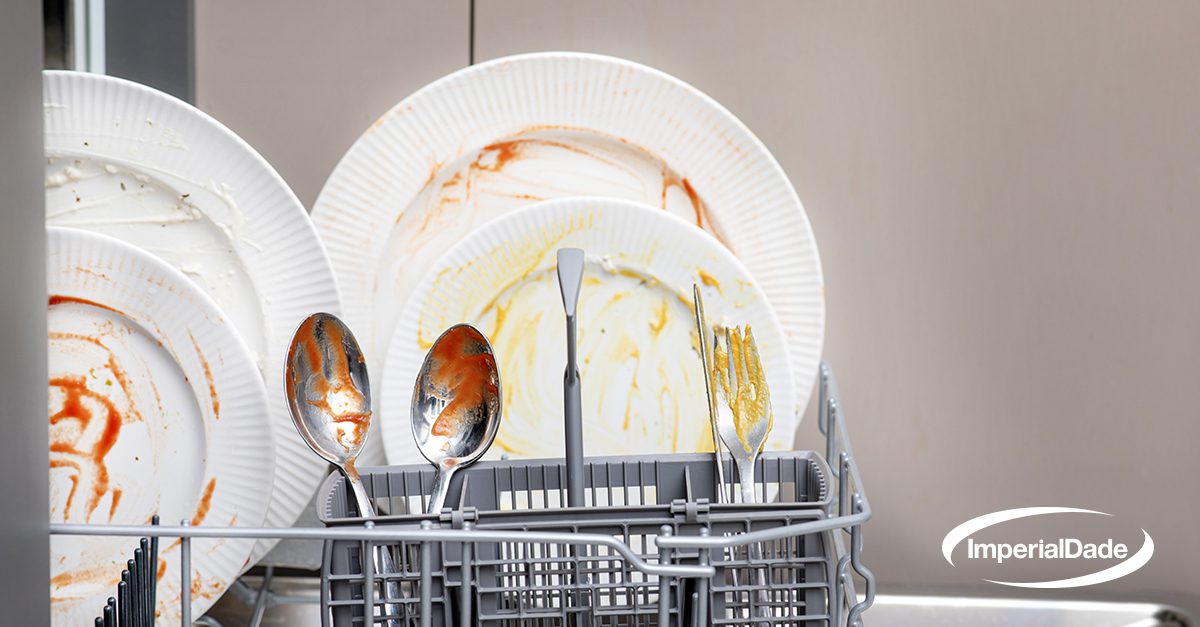Are you experiencing consistent spotty wares and dirty dishes even after a complete wash cycle?
It’s not uncommon for commercial kitchens to have this issue.
Another common issue you may experience with your dish machine is inconsistent wash cycles. One load comes out clean, and the next comes out with a residue or covered in food debris, or maybe it has a foul odor.
Sound familiar?
How much time, product, and energy has staff wasted rewashing dishes? It can put a tremendous strain on the whole operation when there aren’t enough clean dishes to meet demand.
So what’s going on then? Unfortunately, it isn’t a simple answer.
There are many reasons why a dishwasher could be leaving dishes dirty. To make it easier for you to troubleshoot, our food service experts have identified five of the most common causes of spotty dishes in the dishwasher.
- Failure to Scrape and Pre-Rinse Dishes
- Issues with Loading the Dishwasher Correctly
- Issues with Dish Machine Temperature
- Issues with Your Dishwasher Chemical Dispenser
- Issues with Dishwasher Low Water Pressure
1. Failure to Scrape and Pre-Rinse Dishes
It’s essential to scrape and pre-rinse dishes before loading them. By doing so, you’re removing any food debris that’s left on the dishes. Why is that essential, you may ask? A lot of the time food debris is to blame for the dishwasher leaving dishes dirty.
If food debris isn’t scraped and rinsed from dishes before they’re loaded, an excess can build up in the dishwasher. When that happens it can end up contaminating the clean water, clogging components of the dish machine, and spreading to other, clean dishes.
As a result, not only will you experience increased rewash rates, but the machine may need to be cleaned as well, putting it out of commission.
To prevent this, you should be sure to train both experienced workers and new hires to always scrape and pre-rinse dishes before loading them into the dishwasher.
2. Issues with Loading the Dishwasher Correctly

This is one of those issues that most people don’t even think twice about. They just put the dish somewhere where it fits until there’s no more room.
The issue with that is that it can cause shielding.
Shielding occurs if dishes are blocking or overlapping each other. When this is the case, the dish that’s blocked isn’t adequately exposed to water and detergent. As a result, the dish can’t be cleaned or sanitized.
This is why you get spotty dishes and spotty glasses more often if the tray is overcrowded.
The solution for this issue is to follow proper racking procedures, such as placing glasses, bowls, or pots upside down.
Pro Tip: To learn more about proper racking procedures, check out our video:
3. Issues with Dish Machine Temperature
Another cause of spotty dishes is when a dish machine isn’t meeting the minimum wash and rinse temperatures.
If your machine isn’t at the right temperature, then not only are dishes not clean but they’re not being sanitized either. This can lead to major issues health issues for guests and staff. For that reason, if you learn your machine is not properly meeting minimum temperature requirements during a wash cycle, it’s important to immediately shut the dish machine down and call an equipment specialist to address the issue.
The recommended dish machine temperature is different depending on whether you have a low or high-temperature machine. Let’s take a look at what that difference is.
High-Temperature Machines
A minimum temperature of at least 150F – 160F for high-temperature machines is standard. With that being said, it’s always safe to follow the manufacturer’s recommended temperature settings for your machine.
Low-Temperature Machines
For all low-temperature machines, a minimum temperature of at least 120F is standard. Again, always check the manufacturer’s recommendations for your specific model. This can typically be found right on the machine.
4. Issues with Your Dishwasher Chemical Dispenser
This should come as no surprise, but if the dishwasher chemical dispenser isn’t working right then it’s likely to leave dishes dirty after washing.
Why is that the case? For commercial dishwashers, the detergent and rinse additive are introduced during the wash and rinse cycle through a dispensing system.
The way the dispensing system behaves is different depending on whether you have a low-temperature or high-temperature dishwasher. Let’s take a closer look at each.
Low-Temperature Machines
The chemical release for low-temperature machines is on a timer. When the timer isn’t correctly calibrated it’ll either cause too much or too little detergent to release.
You can tell whether you’re receiving too much or too little detergent by tracking how often you run out of product.
If it’s lasting longer than usual, chances are not enough detergent is getting released.
If it’s running out faster than usual, chances are too much detergent is getting released. In this case, you’re either losing product or your dishes aren’t getting sanitized during the wash cycle.
Another way to find out is by testing the sanitizer chemical concentration with a chlorine indicator strip. The concentration should be between 50 and 100 PPM for chlorine sanitation.
High-Temperature Machines
The chemical release for a high-temperature machine is usually controlled by probes located in the dish machine’s wash tank called “cells”.
The function of a cell is to measure the water’s alkalinity levels and release chemicals as needed. However, the cells are unable to perform this vital duty if they get covered in food buildup and debris.
How would that happen? One of the most common answers is food debris and limescale.
If cells are covered in either, they can have a hard time getting an accurate read on the water’s level of alkalinity. As a result, too little or too much chemical can be released into the tank.
Fortunately, it’s easy to prevent this from happening. Just rinse off and clean the cell a few times a week to keep them free of food debris.

Another possibility could be that the chemical dispenser’s squeeze tube has worn out. If your chemical dispenser uses liquid detergent, it will deliver the detergent to the unit through a part of the dispenser called the squeeze tube.
If the squeeze tube wears out, it won’t pump detergent anymore. When this happens, detergent isn’t making its way into the dish machine, so the dishes come out dirty. The only fix here is to have a technician replace the squeeze tube.
5. Issues with Dishwasher Low Water Pressure
The last issue leading to spotty and dirty wares after a wash cycle that we will cover, is low pressure in the dish machine.
Most of the time, low water pressure is the result of food debris buildup, limescale buildup, or soap accumulation clogging the wash and rinse jets. Limescale can also build up in the solenoid valve or water pressure regulator, which would reduce the water pressure going into your machine.
When the jets are clogged there won’t be enough water pressure to clean or sanitize the dishes, which is what causes them to come out dirty.
To cut down on food debris build-up, encourage staff to rinse and pre-scrape dishes before loading them.
As for limescale buildup, an occasional deliming will prevent that from happening. However, if you suspect limescale buildup in the solenoid valve or pressure regulator, then you’ll have to call a technician to repair or replace those parts.
To avoid soap accumulation, clean the dish machine or run a rinse cycle at the end of each night. Don’t forget to let it air dry overnight! Otherwise, bacteria can begin to form.
Final Thoughts
A commerical dish machine is one of the most important parts of a well-functioning kitchen.
If your dish machine continues to leave dishes dirty after a cycle, it is time to troubleshoot.
Use this article to identify five of the most common reasons a dishwasher leaves dishes dirty.
If none of the above seems to be the issue with your machine, it is time to reach out to an equipment specialist.
Our equipment specialists have lifetimes of professional experience with food service equipment. If your problems persist and you’re not sure what to do, reach out to an Imperial Dade facility near you.
One of our equipment specialists will set up a time to visit your facility and perform an evaluation of your dishwasher. Call today to book your free evaluation.
